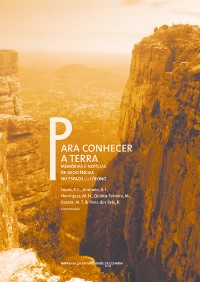Please use this identifier to cite or link to this item:
https://hdl.handle.net/10316.2/31500| Title: | Geomorfologia e meio ambiente: uma contribuição ao estudo de áreas degradadas nos Sertões dos Inhamuns/Cratéus (Ceará, Brasil) | Other Titles: | Geomorphology and the environment: a contribution to the study of degraded area in the Inhamuns/Cratéus hinterlands (Ceará, Brazil) | Authors: | Muniz, A. C. F. Oliveira, V. P. V. de |
Keywords: | Environmental geomorphology;Semi-arid;Hinterland of Inhamuns;Hinterland of Crateús;Environment;Geormorfologia ambiental;Semi-árido;Sertão dos Inhamuns;Sertão de Crateús;Meio ambiente | Issue Date: | 2012 | Publisher: | Imprensa da Universidade de Coimbra | Journal: | http://hdl.handle.net/10316.2/24406 | Abstract: | The article focuses on the environmental degradation/desertification that occur
in the Hinterland of Inhamuns, represented by the municipalities of Arneiroz and Tauá,
and in the Hinterland of Crateús, represented by the municipality of Independence, as they
belong to the ASDs (area susceptible to desertification) of the State of Ceara, considering that
Environmental Geomorphology is a study area that can contribute to detect land degradation
in semi-arid regions and the natural processes of environmental vulnerability that can occur
in such areas. The theoretical methodological reference has been conducted by the geossystemic
bias according to BERTRAND (1969), SOTCHAVA (1976) and TRICART (1977) and by
geomorphologic studies developed by HART (1986) and GUERRA (2003). For the identification
of geomorphologic features, GIS techniques have applied using Geographic Information
Systems (GIS) applied to the composition of the geomorphologic mapping proposed by GOMES
et al. (in RADAMBRASIL, 1981) on a scale of 1:500.000 of the sheet Jaguaribe/Christmas;
Geographic Coordinate System (Datum SIRGAS/2000-municipal limits, IBGE, 2007). As a
result, it was found that the disorganized human occupation, coupled with the sharp semi-arid
conditions, contribute to intensify the spreading of the degradation/desertification processes, as
the study are shows O artigo enfoca a degradação/desertificação ambiental que ocorre no Sertão dos Inhamuns, representado pelos municípios de Tauá e Arneiroz, e Sertões de Crateús constituído pelo município de Independência, em virtude dos mesmos fazerem parte das ASDs (Áreas Suceptiveis à Desertificação) no Estado do Ceará, considerando a Geomorfologia Ambiental como área de estudo que pode auxiliar no diagnóstico da degradação das terras de regiões semi-áridas e os processos de vulnerabilidade ambiental natural existentes nessas áreas. O referencial teórico metodológico foi orientado pelo viés geossistêmico na perspectiva de BERTRAND (1969), SOTCHAVA (1976) e TRICART (1977) e de estudos geomorfológicos contemplados por HART (1986) e GUERRA (2003). Para a identificação das feições geomorfológicas, utilizou-se técnicas de Geoprocessamento, através de Sistemas de Informações Geográficas (SIGs), para a composição do mapeamento geomorfológico proposta por GOMES et al. (in RADAMBRASIL, 1981) na escala de 1:500.000 da folha Jaguaribe/Natal; Sistema de Coordenadas Geográficas (Datum SIRGAS\2000 – Limites municipais, IBGE-2007). Como resultados verificou-se que a ocupação humana desordenada, associada a condições de semi-aridez acentuada, contribuem para que se propague, com mais intensidade, o processo da degradação/desertificação, a exemplo da área em estudo |
URI: | https://hdl.handle.net/10316.2/31500 | ISBN: | 978-989-26-0534-0 (PDF) | DOI: | 10.14195/978-989-26-0534-0_49 | Rights: | open access |
| Appears in Collections: | Para conhecer a Terra: memórias e notícias de Geociências no espaço lusófono |
Files in This Item:
| File | Description | Size | Format | |
|---|---|---|---|---|
| 49-para_conhecer_a_terra_artigo.pdf | 949.97 kB | Adobe PDF |  |
Items in DSpace are protected by copyright, with all rights reserved, unless otherwise indicated.
